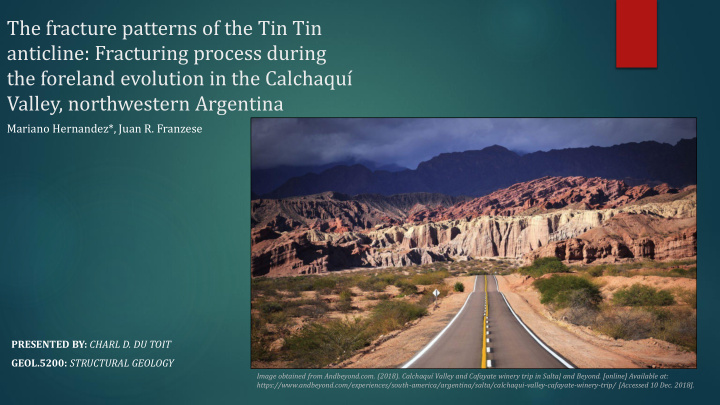



The fracture patterns of the Tin Tin anticline: Fracturing process during the foreland evolution in the Calchaquí Valley, northwestern Argentina Mariano Hernandez*, Juan R. Franzese PRESENTED BY: CHARL D. DU TOIT GEOL.5200: STRUCTURAL GEOLOGY Image obtained from Andbeyond.com. (2018). Calchaquí Valley and Cafayate winery trip in Salta| and Beyond. [online] Available at: https://www.andbeyond.com/experiences/south-america/argentina/salta/calchaqui-valley-cafayate-winery-trip/ [Accessed 10 Dec. 2018].
Introduction ▪ Structural Stratigraphy ▪ Data collection ▪ Results ▪ Extension fractures ▪ Other mesostructures ▪ Conclusions ▪
Introduction Study focused on the fracture patterns of the carbonate- silicoclastic Yacoraite Fm. In the Tin Tin anticline – a fault- related fold in southern part of the Eastern Cordillera in northwestern Argentina. Study of small-scale structures emphasize the importance of managing the naturally fractured reservoirs of folds and thrust belts In NW Argentina much of the hydrocarbon is trapped in the naturally fractured rocks of the Yacoraite fm. → economic potential
Structural history and Stratigraphy The Calchaqui Valley consist of a series of N-S-oriented valleys that extends between the Puna and the Eastern Cordillera. Area characterized by broadly N-S-striking and west vergent fault-related folds surrounded by basement blocks This framework is extensively assigned to the tectonic inversions of the Salta Group Figures 1d and 1b, modified basin → resulted from Cenozoic from (Hernández and Andean contraction Franzese, 2017 )
Structural history and Stratigraphy Salta group basin → Rift-related Extensional phase during lower-Cretaceous and Paleogene Resulted in isolated grabens and sub-basins These sub-basins were then placed around a structural basement high → Salto - Jujeno High Pirgua subgroup (synrift) overlain by Balbuena subgroup (postrift) In response to decreased tectonic subsidence and relative sea-level rise → shallow Atlantic marine ingression Late postrift stage of basin (Santa Barbara subgroup) also related to thermal subsidence, but during drier climate Andean contraction during Paleogene → resulted in foreland basin filled by Payogastilla Group in the Calchaqui valley Figures 1c, modified from Finally tectonic inversion of the Salta Basin (Hernández and Franzese, 2017 )
Structural history and Stratigraphy NNE-SSW striking, double- plunging, west-vergent anticlinal fold Fault propagated fold in response to the Tin Tin thrust Figures 2, modified from (Hernández and Franzese, 2017 )
Western limb: More isolated and highly strained Backlimb and southern nose of the fold: Sedimentary cover more exposed Precambrian-Cambrian basement core: Metamorphic Sedimentary cover was internally Rift-related deformed shortly before and during Phanerozoic Uplift. sedimentary rocks
Structural history and Stratigraphy The study will focus on the early post-rift Yacoraite sequence of the Salta Group. Santa Barbara subgroup also included due to similar mechanical behavior Yacoraite Formation Thickly bedded alternating sedimentary sequence of • carbonate – siliciclastic rocks Contains cm to 1.5m thick beds of: • Limestone • Sandstone • Stromatolitic boundstones (mainly in upper sections) • Pelites • Entire sequence is 57 meters thick at the Tin Tin anticline • HOWEVER, thrust faulting thickened the unit up to 90 meters Diffuse bedding caused by high brittle • strain (only some parts of Backlimb)
Data collection Field approach to: Measure small-scale fractures in Fracture outcrops and grouping them in different sets based on Fracture types 1. Orientation 2. Relationship to other fractures and 3. structural features Faults Extensi Ex sion Fractures Shear fractures • Joints • Most data was obtained from the En echelon fractures Veins • • Backlimb where scan lines were performed Measured over 800 fractures Fractures data was back-tilted around a horizontal axis parallel to the local strike of bedding
Results • Most fractures perpendicular to beds or disposed at high angle to bedding A: Present orientation (folded) B: Bedding dip removal (unfolded data – • Two high-frequency groups observed, forming considering each dip domain) a broadly oblique or ladder pattern • At high angle to bedding C: Representative outcrop with common fracture sets
Extension Fractures: Joints, veins and normal faults Cm- to – meter long, bed-perpendicular and planar • joints with plumose structure on the surface Exhibit ladder pattern • Strikes from ENE to ESE • Generally they bordered by shorter NNW to NNE • cross-joints Distributed evenly along the anticline • E-W striking, high angle to bedding fractures with normal displacement are also present N-S-trending fractures are absent at hinge zone, which is what one would expect in a folded layer.
Shear Fractures: Mesoscale strike-slip and thrust faults Strike-slip faults composed of bed- • perpendicular, cm-m scale, roughly planar fractures and en echelon vein arrays (to lesser extent) A: Dextral & Sinistral strike-slips • represented by shear fractures and en echelon vein arrays B: Conjugate en echelon vein array • C & D: ENE-striking dextral fault • (fracture array and vein array) E: ESE-striking Sinistral en echelon vein • array
Conclusion Mesoscale fractures in the Yacoraite Fm. in the Tin Tin anticline = joints, veins, small-scale strike-slip faults + less significant stylolites and normal faults These features are related to thrust belt-foreland basin system that was constructed during Eocene times at the onset of the Andean contraction. Extension fractures developed in response to N-S directed stretching Small-scale faults and stylolites formed during succeeding ESE-WNE layer-parallel shortening All fractures formed prior or during the infant stages of folding and faulting which led to the tectonic inversion of the Calchaquí Valley
Conclusion Naturally fractured reservoirs are often related to anticlinal formation However, this study revealed that not all fractures found in folded strata are a consequence of the folding events Thus, fractures were present prior to folding. The study also high-lighted that pre-folding fractures may play a vital role in secondary fracture development during the fold evolution → changing or inhibiting classical folding-related deformation patterns “This statement must be taken into account regarding the potential implications of the hydrocarbon exploration and production, focusing on the naturally fractured reservoirs of NW Argentina.” - Hernández and Franzese, (2017)
Hernández, M. and Franzese, J. (2017). The fracture patterns of the Tin Tin anticline: Fracturing process during the foreland evolution in the Calchaquí Valley, northwestern Argentina. Journal of Structural Geology , 96, pp.54-64.
Recommend
More recommend